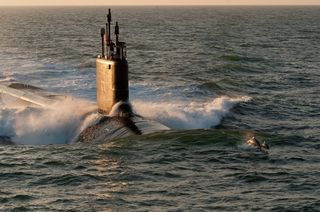Foreign Policy
By Bates Gill
After two decades of steep reductions, the pace of nuclear disarmament has begun to slow. According to data from the Stockholm International Peace Research Institute (SIPRI), the world's nuclear armed states still possess about 4,400 operational nuclear weapons — 2,000 of which are kept on high alert — and some 14,600 additional warheads are in storage for possible use. About 95 percent of these weapons of mass destruction — around 18,000 warheads — are held by Russia and the United States, more than 20 years after the end of the Cold War.
Of course, nuclear disarmament was always going to be hard slogging. Many decision-makers have a deep interest in retaining these weapons for political and security reasons. And, yes, there is a certain accepted comfort level, or even complacency, with the decades-long existence of nuclear weapons and the dark logic of deterrence. Even under these conditions, nuclear disarmament has seen some significant progress in recent years — but only as long as nuclear-armed parties believed deterrence could be preserved even as overall numbers of nuclear weapons were reduced.
Looking ahead, however, the longstanding theories of nuclear stability are likely to come under increasing strain with the continued development of advanced conventional weapons technologies that can substantially affect nuclear capabilities. Such technologies are not entirely new, but their improved effectiveness — especially as overall numbers of nuclear weapons decrease — increasingly erodes what has been a traditional operational and doctrinal distinction between nuclear and conventional forces. This in turn raises critical questions about nuclear postures and deterrence strategies, which will affect disarmament efforts.
What are some of these conventional capabilities? Let's look at three that have received a good bit of attention.
Perhaps the best known are anti-ballistic missile technologies, or missile defenses, which come in a variety of forms and missions. But in a nutshell, these are weapons systems that can track, intercept, and destroy an enemy missile. Current versions of these weapons tend to be of the "kinetic kill" variety — a "bullet hitting a bullet" — but other forms, such as directed-energy weapons (e.g., lasers), have also been explored.
Strategists have long debated the impact of missile defenses on nuclear stability; after all, if one side can entirely negate the other's ability to launch a nuclear strike, then it may not be deterred from launching one itself. Missile defenses were an early sticking point in arms control negotiations between the United States and the Soviet Union — and they remain one today. Judging from Moscow's repeatedly expressed concerns about America's growing anti-ballistic missile capabilities and the impact its leaders claim they have on Russia's deterrent, further bilateral reductions will surely be slowed.
Countries that have a far smaller arsenal of nuclear weapons and delivery systems — for example, China has perhaps only 30 to 40 nuclear-armed missiles with ranges capable of reaching the U.S. mainland — are especially concerned about advances in anti-ballistic missile technologies. Their answer? More missiles with more modern capabilities. And, to further complicate the picture, countries such as China, Russia, and India are pursuing their own anti-ballistic missile capabilities as well, which will in turn affect their potential nuclear adversaries' thinking about the wisdom of smaller arsenals.
A second set of conventional weapons capabilities are conventional long-range (or global) precision-strike weapons. In the United States, such systems — which fall within the Prompt Global Strike initiative — have gained some currency over the past decade as the result of a perceived need to be able to attack targets anywhere in the world with great accuracy, to do so quickly, and, if necessary, to do so from the U.S. homeland and not from forward bases. The types of systems foreseen for this mission would include long-range missiles converted from a nuclear to a conventional role.
Also within the Global Prompt Strike effort are hypersonic glide vehicles. These weapons are still in testing phases, including recent flight tests by the Defense Advanced Research Projects Agency and the U.S. Army Space and Missile Defense Command. In essence, this weapon system consists of two parts: a launch vehicle and a glide vehicle. Boosted toward space by a rocket, a glide vehicle about the size of a fighter aircraft is released at the uppermost edge of Earth's atmosphere onto a controlled, non-ballistic glide path. Traveling at speeds of more than Mach 20 and covering enormous distances in a short period of time — one newspaper account noted the vehicle could travel from Sydney to London in about 49 minutes — the vehicle, armed with conventional munitions, can be guided to hit its target with devastating effect.
At least three important implications for disarmament arise from the deployment and possible use of such conventional systems. The first is the possibility that when such weapons are readied or launched, nuclear-armed adversaries cannot be certain they are actually conventionally-armed, and may be prompted to launch a nuclear response. Second, such conventional weapons, being both highly accurate and tremendously destructive, could be capable of destroying all or key parts of an opponent's nuclear arsenal and related infrastructure. Finally, some countries, such as China, have stated for decades that they would not use nuclear weapons unless attacked by nuclear weapons first. But what if their nuclear arsenal or other strategic infrastructure is destroyed or seriously debilitated by conventional weapons? Does that elicit a nuclear response nonetheless? Will this possibility lead the Chinese to rethink their longstanding nuclear "no-first-use" principle? In all of these scenarios, advanced conventional capabilities of long-range precision strike could undermine nuclear restraint and disarmament.
The Americans are not the only ones who are looking for advantage in the widening gray zone between conventional and nuclear capabilities. As John W. Lewis and Xue Litai recently explained in the Bulletin of the Atomic Scientists, China's co-mingling of conventional- and nuclear-armed missiles on the same bases may well lead to the same problem noted above: potential adversaries might assume the worst and respond in kind when only conventional missiles were actually launched. Or, as some Chinese strategists would prefer to believe, an adversary is not likely to launch its nuclear weapons precipitously for fear that an unwarranted nuclear attack would invoke a devastating Chinese nuclear response. Either way, the introduction of Chinese conventional forces into this strategic picture does not argue in favor of nuclear reductions.
Finally, cyber weapons are a third conventional capability that will likely affect nuclear arsenals and deterrence strategies, but that have received little attention in this context. The strategic capabilities of cyberattacks are still in their infancy. But as revelations about U.S. and Israeli cyberattacks against Iranian nuclear facilities show — including the so-called "Stuxnet" computer worm, which destroyed centrifuges at the Natanz enrichment plant — much time and investment has gone into advancing this frontier in weapons science, and this will surely continue.
Those tasked with protecting their countries' nuclear weapons will surely be concerned that those capabilities could be disabled by cyberattacks and will take steps to prevent that from happening. In addition, the origins of cyberattacks are difficult to trace. The possibility of an anonymous cyberattack could also prompt nuclear-armed states to be even less forthcoming in "softer" areas of arms control, such as transparency and other confidence-building measures, for fear that such information could be exploited. In the face of these challenges, a rational response is probably not further reductions, but rather steps to strengthen nuclear arsenals, certainly qualitatively, and possibly quantitatively as well, to assure deterrence through redundancy, higher readiness, and the maintenance of sufficient numbers of weapons.
Looking ahead, expectations for further nuclear reductions are not entirely doomed. U.S.–Russia talks will continue and their arsenals will shrink somewhat further under current agreements. It is possible that China, France, Russia, the United Kingdom, and the United States — the five recognized nuclear powers under the Nuclear Nonproliferation Treaty — may even formalize multilateral discussions on how to achieve further cuts amongst themselves.
But overall — with the improvement and proliferation advanced conventional capabilities — the major nuclear powers are coming to a critical disarmament crossroads that will demand far greater confidence amongst them so that significant new reductions are possible while still preserving a fundamentally stable deterrence dynamic. As such, all nuclear-armed states will increasingly rethink the foundations of strategic stability, their own nuclear postures, and the benefits of smaller arsenals. The phrase "fewer but newer" may best sum up the future disarmament situation: fewer nuclear warheads, but newer systems — especially in the conventional realm — with the potential to transform the global strategic landscape and make the task of complete nuclear disarmament an even more difficult prospect.
This article was originally published at Foreign Policy




